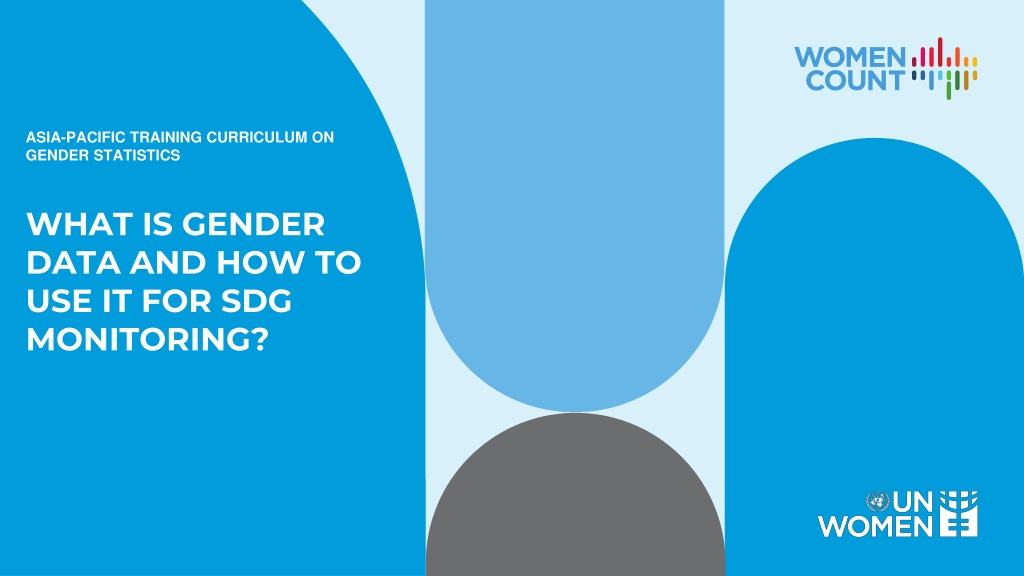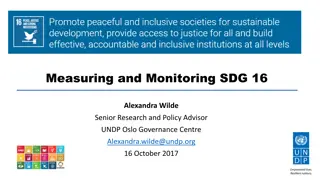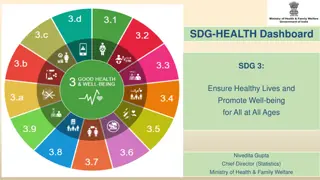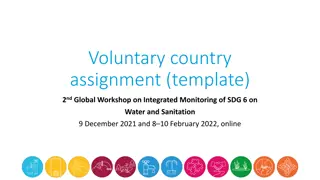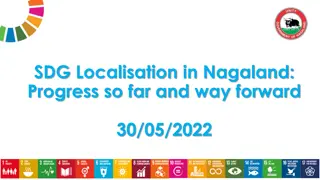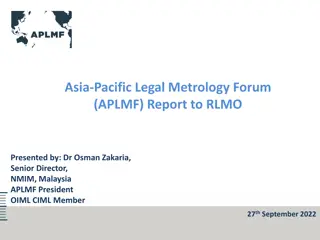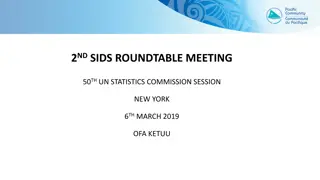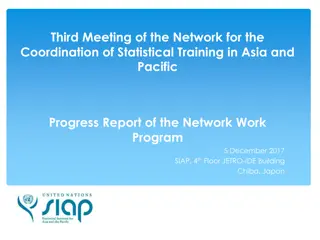Understanding Gender Data for SDG Monitoring in Asia-Pacific Training Curriculum
This training curriculum delves into the nuances of gender data, distinguishing between sex and gender, and emphasizes the importance of gender statistics for monitoring Sustainable Development Goals (SDGs). It covers the significance of disaggregating data by sex to produce gender statistics, which encompass a broader scope of information beyond biological differences. By understanding gender data, participants can advocate for inclusivity and address challenges in obtaining gender-related SDG data.
Download Presentation

Please find below an Image/Link to download the presentation.
The content on the website is provided AS IS for your information and personal use only. It may not be sold, licensed, or shared on other websites without obtaining consent from the author. Download presentation by click this link. If you encounter any issues during the download, it is possible that the publisher has removed the file from their server.
E N D
Presentation Transcript
ASIA-PACIFIC TRAINING CURRICULUM ON GENDER STATISTICS WHAT IS GENDER DATA AND HOW TO USE IT FOR SDG MONITORING?
- Become familiar with the concepts of sex and gender - Understand the multidisciplinary nature of gender statistics. - Gain knowledge on how gender statistics can help monitor the SDGs from a gender angle, in the spirit of inclusiveness. 1 Learning objectives - Understand the reasons behind the lack of some gender-related SDG data, and potential solutions to overcome related challenges.
WHAT IS GENDER DATA Sex vs. Gender Sex vs. Gender Sex Sex refers to the biological differences between women and men Gender Gender refers to the role of a woman or man in society, it is constructed over time Generally, data is disaggregated by sex Sex-disaggregated statistics are part of gender statistics, but gender statistics are much broader 1| MAKING EVERY WOMAN AND GIRL COUNT | 2020
SEX OR GENDER? Sex 1) AFTER DELIVERY THE DOCTOR WILL REVEAL TO THE MOTHER THE ____ OF THE CHILD 2) IN ORDER TO UNDERSTAND THE DIFFERENCES IN ENROLMENT RATES BETWEEN GIRLS AND BOYS, THE DATA MUST BE DISAGGREGATED BY ____ Sex Sex Gender 3) A PERSON S _____ MIGHT OR MIGHT NOT ALIGN WITH HIS OR HER _______ IDENTITY Sex 4) DATA IS TYPICALLY DISAGGREGATED BY BINARY DEFINITIONS OF _____, BUT SOME COUNTRIES ARE STARTING TO DEVELOP METHODOLOGIES TO CAPTURE ______ DIMENSIONS AND APPLY THESE FOR DISAGGREGATION Gender Gender 5) WOMEN AND MEN S ______ ROLES IN SOCIETY DETERMINE HOW MUCH TIME THEY SPEND DOING DOMESTIC WORK Sex Gender Gender 6) ______ STATISTICS INCLUDE _____ DISAGGREGATED STATISTICS AND OTHER ______ SPECIFIC INDICATORS THAT CAPTURE THE REALITIES AND THE DIFFERENCES IN THE LIVES OF WOMEN AND MEN # | MAKING EVERY WOMAN AND GIRL COUNT | 24 July 2019
GENDER STATISTICS -Gender Statistics capture the specific realities in the lives of women and men - Gender statistics go well beyond sex-disaggregation - Gender statistics comprise: - Sex-disaggregated data - Data pertaining specifically to women or to men - Data that captures specific gender issues (even when non explicit) -Gender data cuts across all areas of sustainable development # | MAKING EVERY WOMAN AND GIRL COUNT | 24 July 2019
ARE THESE GENDER STATISTICS? Proportion of population living in slums, by sex Maternal mortality ratios, per 100,000 live births Incidence of prostate cancer Tobacco use rates in China Proportion of households using clean fuels for cooking and heating Total value of inward and outward illicit financial flows, in USD # | MAKING EVERY WOMAN AND GIRL COUNT | 24 July 2019
GENDER DATA VS GENDER STATISTICS -Gender data are data points for men, women or for issues that affect women or men particularly. -Gender statistics are the estimates calculated utilizing gender data. -In practice, and throughout these course, both words are often used interchangeably. Image source: Studybay group # | MAKING EVERY WOMAN AND GIRL COUNT | 24 July 2019
GENDER AND THE SUSTAINABLE DEVELOPMENT GOALS (SDG) The 2030 Agenda for Sustainable Development: - Adopted by all UN Member States in 2015 - Provides a shared blueprint for peace & prosperity for people and the planet. - At its heart are the 17 Sustainable Development Goals (SDGs) - Each of the 17 Goals include a series of targets - To measure progress towards the targets we use more than 200 indicators - The SDGs are a follow-up to the MDGs, but apply for developed and developing countries # | MAKING EVERY WOMAN AND GIRL COUNT | 24 July 2019
GENDER ACROSS THE SDG INDICATOR FRAMEWORK - Gender indicators are present across many SDG goals. - Well beyond goal 5. - Without gender equality the SDGs cannot be achieved - Without gender statistics, inclusive progress towards the SDGs cannot be measured Image source: Turning promises into action. UN Women 2018 # | MAKING EVERY WOMAN AND GIRL COUNT | 24 July 2019
GENDER ACROSS THE SDG INDICATOR FRAMEWORK Distribution of Gender Specific Indicators in the SDG Indicator Framework 35 30 25 20 15 10 5 0 Goal 1 Goal 2 Goal 3 Goal 4 Goal 5 Goal 6 Goal 7 Goal 8 Goal 9 Goal 10Goal 11 Goal 12Goal 13Goal 14 Goal 15Goal 16Goal 17 Total no. of indicators No. of Gender Specific Indicators # | MAKING EVERY WOMAN AND GIRL COUNT | 24 July 2019
TYPES OF GENDER INDICATORS FOUND ACROSS THE SDG MONITORING FRAMEWORK 1) Targeted gender-specific indicators Image source: Turning promises into action. UN Women 2018 # | MAKING EVERY WOMAN AND GIRL COUNT | 24 July 2019
TYPES OF GENDER INDICATORS FOUND ACROSS THE SDG MONITORING FRAMEWORK 2) Sex disaggregation is explicitly mentioned Image source: Turning promises into action. UN Women 2018 # | MAKING EVERY WOMAN AND GIRL COUNT | 24 July 2019
TYPES OF GENDER INDICATORS FOUND ACROSS THE SDG MONITORING FRAMEWORK 3) Additional indicators that capture a gender angle (gender- relevant) Image source: Turning promises into action. UN Women 2018 # | MAKING EVERY WOMAN AND GIRL COUNT | 24 July 2019
TYPES OF GENDER INDICATORS FOUND ACROSS THE SDG MONITORING FRAMEWORK Other indicators across the framework might not be gender specific but are still gender- relevant, as additional disaggregation could potentially be performed Image source: Azcona, Duerto, Bhat, 2020. Harsh Realities: Marginalized women in cities of the developing world. # | MAKING EVERY WOMAN AND GIRL COUNT | 24 July 2019
WHY ARE GENDER STATISTICS IMPORTANT? WITHOUT GENDER DATA WE ARE GETTING AN INACCURATE PICTURE. # | MAKING EVERY WOMAN AND GIRL COUNT | 24 July 2019
WHY ARE GENDER STATISTICS IMPORTANT? Policy making Accountability Advocacy ACHIEVE THE SDGs FOR ALL Analysis/Academic research # | MAKING EVERY WOMAN AND GIRL COUNT | 24 July 2019
WHY ARE GENDER STATISTICS IMPORTANT Image source: The better India # | MAKING EVERY WOMAN AND GIRL COUNT | 24 July 2019
KEY AREAS WITH GENDER GAPS IN ASIA AND THE PACIFIC Largest data gaps New and emerging areas of statistics Hard to reach population groups Pacific Island Countries and territories # | MAKING EVERY WOMAN AND GIRL COUNT | 24 July 2019
ENHANCING AVAILABILITY AND USE OF GENDER DATA SOLUTIONS (INCLUDING WOMEN COUNT) CHALLENGES TO GENDER DATA PRODUCTION/USE Strategies/Laws prioritize gender data Gender-sensitive SDG localization Intergovernmental work for methodological developments and S-S cooperation Lack of political will Inadequate resources Weak policy space Enabling environment Build capacity in technically challenging areas such as Time Use, Environment, Violence surveys Reprocess existing data Limited coordination among NSS actors Limited technical capacity in methodologically challenging areas Technical challenges Gender data production Communicating data efficiently Better exchanges (SDMX) User-producer dialogues Limited awareness Insufficient dissemination/communication User-producer disconnect Data Lack of access to data dissemination & use Source: Making Every Woman and Girl Count Inception document # | MAKING EVERY WOMAN AND GIRL COUNT | 24 July 2019
